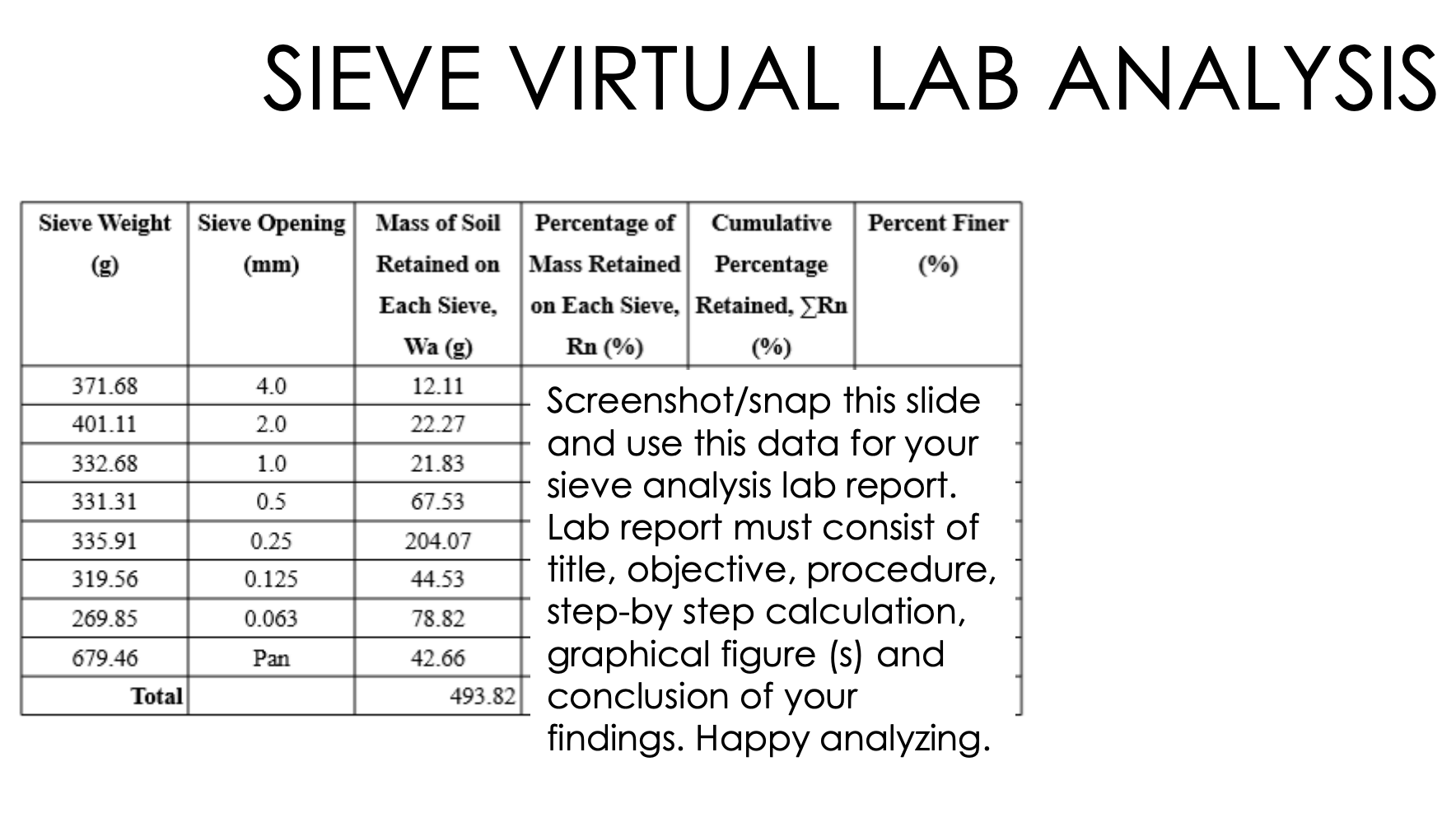Sieve Analysis Lab Report
Similar to Sieve analysis of coarse and fine aggregate - Report. Each sieve shall be inspected visually for bent or distorted wires after each use.
Sieve Analysis Properties And Behavior Of Soil Online Lab Manual
For the No4 sieve.

. MANUAL 4 MANUAL OF METHODS OF ANALYSIS OF FOODS. Yield strength ultimate tensile strength Youngs modulus and ductility. It is usually performed for sand and gravel but cannot be used as the sole method for determining the grain size distribution of finer soil.
- AOAC 17th edn 2000 Official Method 96811 Moisture Loss on. Particle Size and Sand Sieve Test Environmental Soil Testing Aluminum Stress Test. Assume that the soil was previously passed though a No.
Sieving- Ed Ryan Ruales. To the anniversary page. This test method is used primarily to determine the grading of materials proposed for use as aggregates or being used as aggregates.
The 100-year success story. Mix well to get a homogenous sample. 3 Calculate the percent passing or percent finer by starting with 100 percent and subtracting the percent retained on each sieve as a cumulative procedure.
The ordinary direct plot is dismissed as unsuited for sizing-diagrams. Retained on each sieve by the original sample mass. Your partner in the lab.
Send us your sample. Particle technology lab report nabeel sultan. Use the template provided to prepare your lab report for this.
Grind the sample in a grinder to pass through No. Store sample in a tightly stoppered bottle. The lab offers comprehensive analyses of soil water plant tissue manure compost and other agricultural materials.
Abstract In this experiment a tensile test is carried out on a mild steel sample. What size are those particles. 10 sieve 395 g.
This experiment is conducted to study the behaviour of. Total mass 500 g. 40 sieve air-dried and then pulverized.
101 Total percentage of material passing each sieve or 101 Total percentage of material retained on each sieve or 101 Percentage of material retained between consecutive sieves. Microscopy or automated image analysis are the only techniques that can describe particle size using multiple values for particles with larger aspect ratios. Arrange the IS sieve in descending 25mm20mm 125mm 10mm 475mm.
Thoroughly mix the soil with a small amount of distilled water until it appears as a smooth uniform paste. The sieve analysis determines the gradation the distribution of aggregate particles by size within a given sample in order to determine compliance. Replace any damaged or nonconforming sieves.
Understanding your Turf Irrigation Water Analysis Report WT01 Understanding your Turf Irrigation Water Analysis Report WT02 Pond and. Four methods of plotting sizing-tests have been described in this paper. We conduct a sample grinding particle or sieving analysis and recommend the right instrument for your application.
Mass retained on No. Report 10 Depending upon the form of the specifications for use of the material under test the report shall include the follow-ing. Possibly the most widely conducted soil tests are those done to estimate the plant-available concentrations of plant nutrients in order to determine fertilizer recommendations in agricultureOther soil tests may be done for engineering geotechnical geochemical or.
4 sieve 97 g. Objectives To study the behaviour of materials under tensile load and to obtain primary parameter values of materials such as. Kitch Angelo State University Direct Shear Test Triaxial Compression Test in Rock What is.
Report percent loss in weight as moisture. Banging the sieve on the floor or hitting the sieve with a hammer will damage the sieve. 2 Weigh four of the empty moisture cans with their lids and record the.
After completion of sieving then weigh the aggregates retained in each sieve note it down. Is a basic essential test for all aggregate technicians. The cumulative direct plot is simple and fulfills most of the requirements tolerably well but it does not permit the representation of the entire.
Sieve Analysis Lab Report Discussion Conclusion. Now fill the sample to the highest sieve and sieve well for up to 10 minutes. Sieve analysis is a method that is used to determine the grain size distribution of soils that are greater than 0075 mm in diameter.
Individual sample grinding sieve and particle analysis. Cover the dish with cellophane to prevent moisture from escaping. Plant tissue analysis is a valuable aid in crop management.
Alone it can be used for making fertilizer recommendations for certain crops such as tree fruits and grapes. The sieve openings by gently working from either or both sides with a trowel or piece of flat metal until the aggregate is freed. Mass retained on No.
Soil test may refer to one or more of a wide variety of soil analysis conducted for one of several possible reasons. Any mechanical sieve-shaking device that accomplishes the same thoroughness of sieving as the hand-sieving procedure described in F1a of this method. For other crops plant tissue analysis in combination with soil test information is the recommended approach for diagnosing nutrient deficiencies and determining fertilizer requirements.
2 Performing a particle size analysis is the best way to answer the question. The final total of the weights retained on each sieve should be within 03 of the original weight of the sample prior to grading. The results are used to determine compliance of the particle size distribution with applicable specification requirements.
Sphere and report the value of some equivalent diameter. Equipment for Preparing Specimens Laboratory Testing Water Content w Atterberg Limits Unconfined Compression Test Soil Consolidation and Oedometer Test Step-by-Step Guide for Grain Size Analysis Geotechnical Engineering Lab Manual by Prof.

Report Of Sieve Analysis For Sample 1amaravathivizhai Channel Upstream Download Scientific Diagram

Sieve Analysis Results Download Table

Screenshot Snap This Slide And Use This Data For Your Chegg Com


Comments
Post a Comment